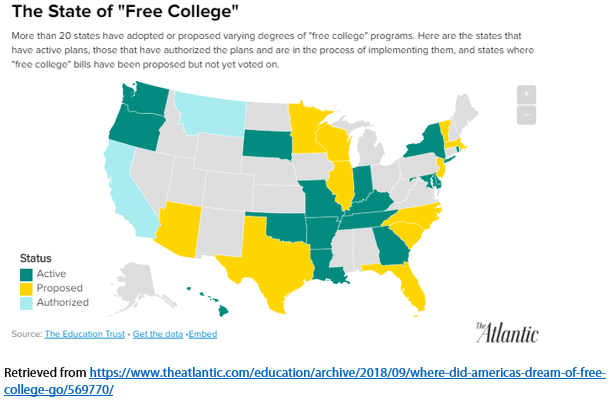Advance CTE wrote a series of blog posts profiling the policies and practices of free college in the United States. This post will explore the future landscape of community college. Check out previous blogs on the history of free college, Indiana’s 21st Century Scholars Program and challenges and limitations to free college programs.
 As of September 2018, there are over 350 local and state college promise programs across the country. Though the source of funding for free college varies , the goal of increasing access despite the growing cost of college is the commonality. So far, the 2018 election cycle has seen a number of candidates include some form of free college in their platform. Overall, ten Democratic gubernatorial candidates are promoting free college in their campaign. For example, Maryland gubernatorial candidate Ben Jealous is advocating for free community college and debt free four-year college, Arizona gubernatorial candidate David Garcia is supporting a proposal to make four-year public colleges free and Connecticut gubernatorial Ned Lamont is proposing making the first two years free at any state public college.
As of September 2018, there are over 350 local and state college promise programs across the country. Though the source of funding for free college varies , the goal of increasing access despite the growing cost of college is the commonality. So far, the 2018 election cycle has seen a number of candidates include some form of free college in their platform. Overall, ten Democratic gubernatorial candidates are promoting free college in their campaign. For example, Maryland gubernatorial candidate Ben Jealous is advocating for free community college and debt free four-year college, Arizona gubernatorial candidate David Garcia is supporting a proposal to make four-year public colleges free and Connecticut gubernatorial Ned Lamont is proposing making the first two years free at any state public college.
At the federal level, various members of Congress have introduced legislation that promotes free college. Perhaps most well known is Senator Bernie Sanders’ (VT-I) “College for All,” proposed in the spring of 2017, that promotes measures such as making all public colleges free for learners with a household income of up to $125,000 and having all community colleges be tuition free. In the spring of 2018 Senator Brian Schatz (HI-D) introduced the “Debt Free College Act” that proposes measures to make college debt free with a focus on the total fees associated with college (such as textbooks, food and housing) instead of only tuition.
The Institute for Higher Education explored the concept of free college, and came up with five ways to fix current programs and build “equity-driven federal and state free-college programs:”
- Invest first and foremost in low-income students;
- Fund non-tuition expenses for low-income students;
- Include four-year colleges in free college programs;
- Support existing state need-based grant programs; and
- Avoid restrictive or punitive participation requirements, such as post-college residency requirements
Additionally, the Education Trust evaluated free college programs through an equity lens, and developed equity driven guidelines to rate and improve current state tuition-free college programs or proposals. They built an eight-step evaluation to use when assessing free college program quality:
- Whether the programs cover living expenses;
- Whether they cover fees;
- Whether they cover the total cost of tuition for at least four years of college;
- Whether they include bachelor’s-degree programs;
- Whether adult students are eligible;
- Whether repayment of aid is required under certain circumstances;
- Whether there are GPA requirements; and
- Whether there are additional requirements to maintain eligibility
Although there is a growing national focus on free college, and even more state-level attention on this issue, a uniform agreement on what this should look like is lacking. There is no general consensus on what free college should look like and the scope of what “free” would truly mean. However, the overarching common goal of making college affordable and accessible will keep the conversation around free college moving forward.
Meredith Hills, Policy Associate


 The idea of free college has gained traction in a number of states. Indiana has been at the forefront of this movement, and has had some form of free college for the past 30 years. Currently, Indiana’s
The idea of free college has gained traction in a number of states. Indiana has been at the forefront of this movement, and has had some form of free college for the past 30 years. Currently, Indiana’s